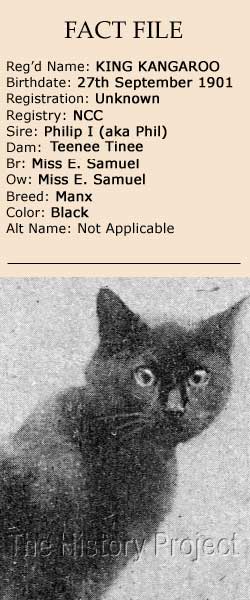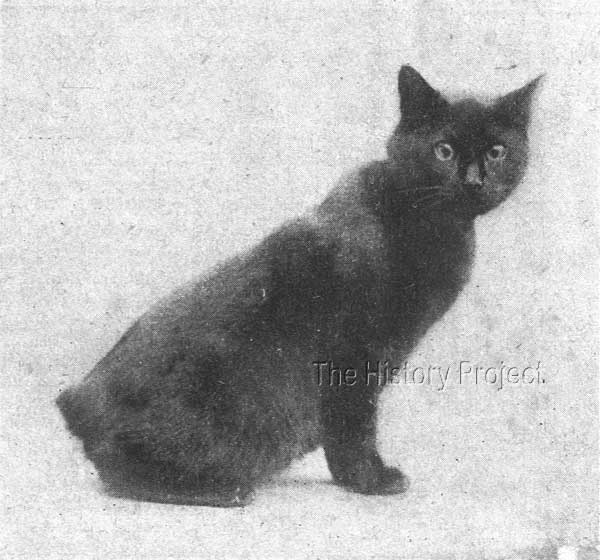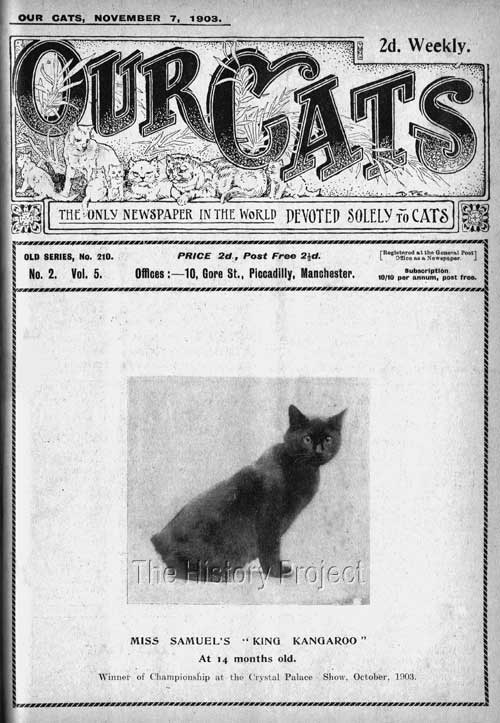 | ||||||||||









|
KING KANGAROO (1901)PHOTOS | SOCIAL MEDIA | REFERENCES
HISTORICAL BACKGROUND:It would be fair to say, that breeders and admirers of Manx cats have generally fallen into the 'minority' camp when compared to other feline breed and show groups. But these sweet and plucky cats have, and will always, appeal to those cat fanciers looking for something uniquely different, or difficult to come by, and with some rare or novel trait. They are usually summarily dismissed, by those cat fanciers who consider that the tail of a cat is an essential feature, one which appeals to their sense of beauty. The Manx fancier, on the other hand, will be smitten by what looks like their foreshortened appearance, their high, rounded rump, and taillessness or stump. Tailed Manx are greatly valued by various Manx breeders and fanciers, as they have the wonderful character and other attributes of the Manx cat, as well as being essential for breeding purposes to maintain the viability and health of this unique breed. Mr. Charles Lane, who himself bred Manx before the turn of the century, tells us that at comparatively few shows were classes provided for this variety, and as a consequence they often had to be entered into the 'any other variety' short-hair category, where he states: "they did not get much chance of getting into the first three, unless exceptionally good in size and markings."7 Manx cats started to come into their own in the latter part of the 1890's, with a growing number of well-educated breeders starting to take an interest in them. Two of the earliest to be found in the Registers were 'Sedgemere Toff' (NCC: 1636), a Silver Tabby male owned by Mrs. S. Woodiwiss, who won a First at the Royal Aquarium Cat Show of 1894; and 'Manx Pickles', (NCC: 2160), a male born in 1893, bred by Mr. E. S. Woodiwiss and owned by a Miss Ashley. 'Pickles' is also listed as the sire of 'Manx Beauty', (NCC: 3254), a Manx female born 5th July, 1895 bred and owned by the same Mr. E.S. Woodiwiss.6 Breeders specialising in Manx at that time included the Woodiwiss brothers, Miss Samuels, Mr. Jungbluth, Mr. & Mrs. H.C. Brooke and Mr. Gambier Bolton. Others to share in this interest were Lady Alexander, Miss Jay (better known for her Blue Persians), Mrs. Moseley, and Miss Hester Cochran, the latter who eventually gave up all other breeds to specialise only in Manx, and who in due course became the Honorary Secretary of the Manx Cat Club when it was duly formed in 1901. That the Manx Club had a difficult time establishing itself is apparent from the writings of both Frances Simpson, and those particularly of 'Dick Whittington', who in the columns of 'The Ladies Field' made her views clear on the 'prejudice' inflicted upon the fledgling club: "When the Manx Club was started, very determined efforts to belittle it were made in some quarters, and it was freely and publicly asserted, that it would 'do no good'. The club has now been established for nearly two years, and it has quite justified its existence. It has steadily worked on giving specials and guaranteeing classes, and otherwise inducing people to exhibit, until at the present time the Manx fancy may be said to be fairly on its legs, and is, at any rate, as strong as the Siamese. To no properly conducted show has the club refused its support, its guarantees and specials have all been paid up, and in every way the club has fairly refuted the aspersions cast upon it."2 PARENTAGE & OWNERSHIP:
Unknown
Philip I
| Unknown
King Kangaroo, Sep-27-1901, Black Manx, M
| Unknown
Teenee Tinee
Unknown
Although 'King Kangaroo' does not seem to appear in any publicly listed register, that he was in fact registered is not in doubt. His details for this article have been drawn from his appearance in articles published in Our Cats from both 1903 and 1904, plus his entry into the Show Catalogue of the Midlands County Cat Club, in 1906. His sire was 'Philip' also known as 'Philip I' or just plain 'Phil' to his friends. 'Philip' was Miss Samuel's main stud cat and the 'king' of her cattery. His dam was Miss Samuel's well-proven Manx queen, 'Teenee Tinee'. 8
Miss Simpson very tactfully points out the difficulty in breeding Manx that are consistently true to type, while according Miss Samuels the greatest honour in beginning to achieve that reality: "It is only of very recent years that any English fanciers have tried to breed true Manx cats. Miss Samuel has been very successful in establishing a strain which again and again breeds true to type. The 'Golfsticks' and 'Kangaroo', two noted winners, are owned by her."1 We are assisted in gauging the great care that Miss Samuel took of her charges from the following missive which she sent to the Editor of Our Cats in March of 1903: "Miss E. Samuel writes: I have had such a busy week with my mother cats, and though there have been some disappointments, I have some grand kittens, and my nursery is almost too many for me to manage comfortably. 'Manx Monarch' has sired some lovely tabbies, and 'Manx Exile' is the proud sire of the loveliest-shaped white and black baby you could wish to see. Though both these cats came to me pedigree-less, I presume from their offspring they came off good parentage. My 'Manx Philip's' offspring are always a success for shape. I have been so successful too, with a poor little starving mite that came here one stormy night begging to be taken in. I couldn't turn her out again, so I gave her a little house all to herself, and though I fed her most carefully she was for days at death's door, just a bag of skin and bones; it made one's heart ache to look at her. A week ago we quite gave her up, but I still persevered with hot water bottle and drops of liquid food, and got her round a bit; and then on Wednesday she had a bad miscarriage, and once more the case seemed hopeless, but I stuck to my guns, and today the kitten is on the road to recovery, and almost human in her expressions of gratitude. She is a very dark tortoiseshell, with such quaint little ways. I wonder anyone could turn her out to die, but unfortunately it is only too common a practice in London, when a cat or kitten gets 'troublesome'. I am entirely in sympathy with the sentiments expressed this week in 'Our Cats' in an article called 'Cats I have known'. I liked reading it very much."3 SIBLINGS & SHOWS:Sad to say, that in the case of Manx cats, very poor efforts were made to record even the most basic information and very often, even when they were registered, important basic details such as their colour or pattern or even their gender, or date of birth, were very often omitted! Certainly some of the earliest cats were of unknown parentage, which can be understood given their acquisition from the Isle of Man, or bred from cats imported from there. Nevertheless it is rare to find full details for more than just a few. In the case of 'King Kangaroo', through both sire and dam, we can track both full and sire-siblings. These include: Full siblings: Sired by 'Philip I' and out of 'Teenee Tinee'. 'MOFF-TOFF', Black Manx female, born 16th May, 1899. Just a sampling of the more notable Sire-Siblings include: 'BEELZEBUB', Black Manx male, born 27th June, 1900. Of his show wins, we have recourse only to minimal information. Other than Frances Simpson referring to him as a Prize-winner, the only reliable win that can be confirmed, was his winning of the Championship at the Crystal Palace Show in October 1903. This win is confirmed in writing, beneath the cover picture of 'Kangaroo' which was featured in the 7th November 1903 edition of Our Cats.3 BREEDING & PROGENY:An excerpt from a letter written by Miss Samuels to the Editor of 'Our Cats' and published in 1st October edition 1904, gives us a clear insight as to why we can find no progeny of 'King Kangaroo' of record. It also has assisted us to confirm his date of birth and his sire. "King Kangaroo was three years old on September 27, and he is still a bachelor. So far I have not been able to persuade him to look with favour on any of my queen cats. He will sit with them for hours without moving, and run off so thankfully when I open the door to let him out. I mean Mokie for a wife for him, but I dare say he will not have anything to do with her. His two objects in life seem to be his love for his mistress and his hatred of his sire. He watches for Phil like a cat for a mouse, and once he got him. I believe Phil would have been killed if I had not been to the rescue, and fortunately I got nearly all the bites and scratches intended for Phil. Phil really ought to go to shows, he is such a big beauty, with a grand head, but he is very nervous, and his mistress is quite unable to spare him, so he has to be content to shine through his children."4 PHOTOS:
SOCIAL MEDIA :
In Summary: Although 'King Kangaroo' was lucky enough to be mentioned in the chapter on Manx in Frances Simpson epic work The Book of The Cat, his image was not included. That is probably because his best wins and his new photograph were not available until a few months after the release of that publication. So apart from those few words, he has almost been lost to us, were it not for his appearance, above, on the cover of Our Cats. Miss Samuels took her breed seriously, and materially, was among the most consistently successful breeders of Manx in her day, despite Manx sometimes being difficult to rear. It is to her credit that not only Frances Simpson, but also Miss Higgins (alias 'Dick Whittington') had this to say about her: "I am glad to say that we have at present two or three breeders who have procured, with great pains, large studs of good Manx cats, and are working steadily to establish strains which will breed true to type. Miss Samuels' black Manx cats are well known, and she has so far been our most successful breeder, for in litter after litter really good kittens have predominated..."2 'King Kangaroo's successes followed on from those of 'Golfsticks'. Nothing is more noticeable or desirable than consistency of breeding to type, health and character. Miss Samuels had begun to set new standards for others to follow. REFERENCES:
Registers associated with this article include The Incorporated Cat Fanciers Association of Great Britain (TICFAGB), National Cat Club (NCC), The Cat Club (CCR), Beresford Cat Club (BCC), Feline Federation Francaise (FFF), Siamese Cat Registry (SCR), US Register & Studbook for Cats (USR)including Supplement(USRS), The Studbook of the American Cat Association (ACA), and the Studbook & Register of the Cat Fanciers' Association (CFA).
|
|||||||||
Home | Cats | Gallery | Clubs | People | Artifacts | Articles | Updates | Contact Us ©The CFA Foundation, Inc and The Harrison Weir Collection
|
||||||||||



